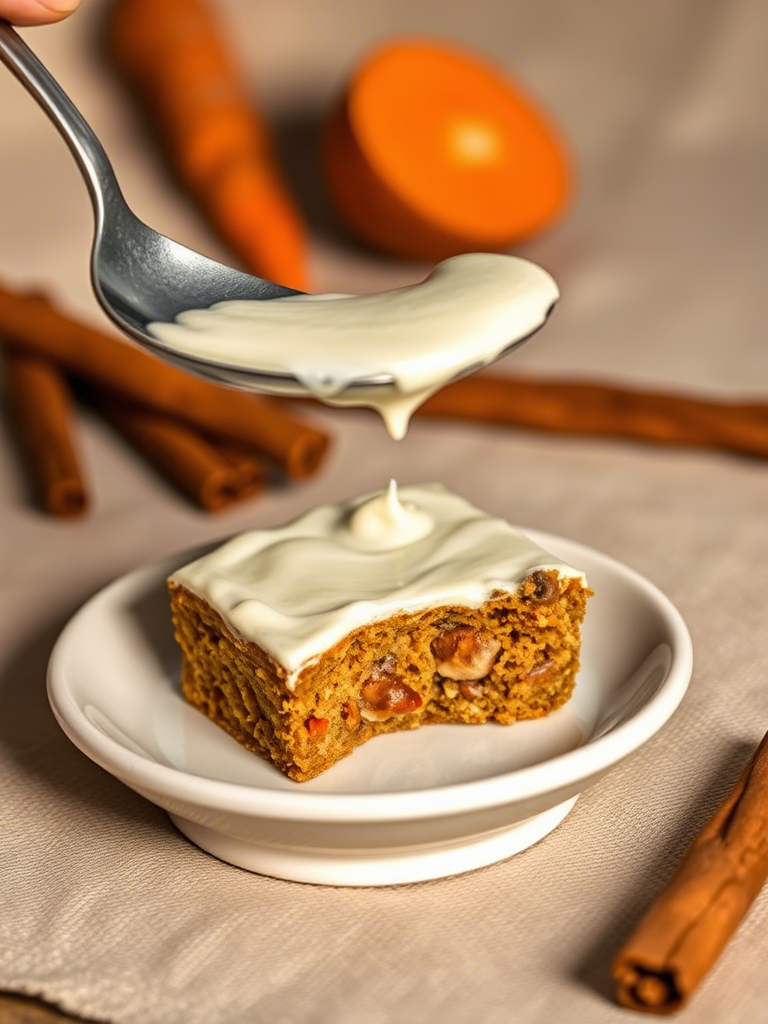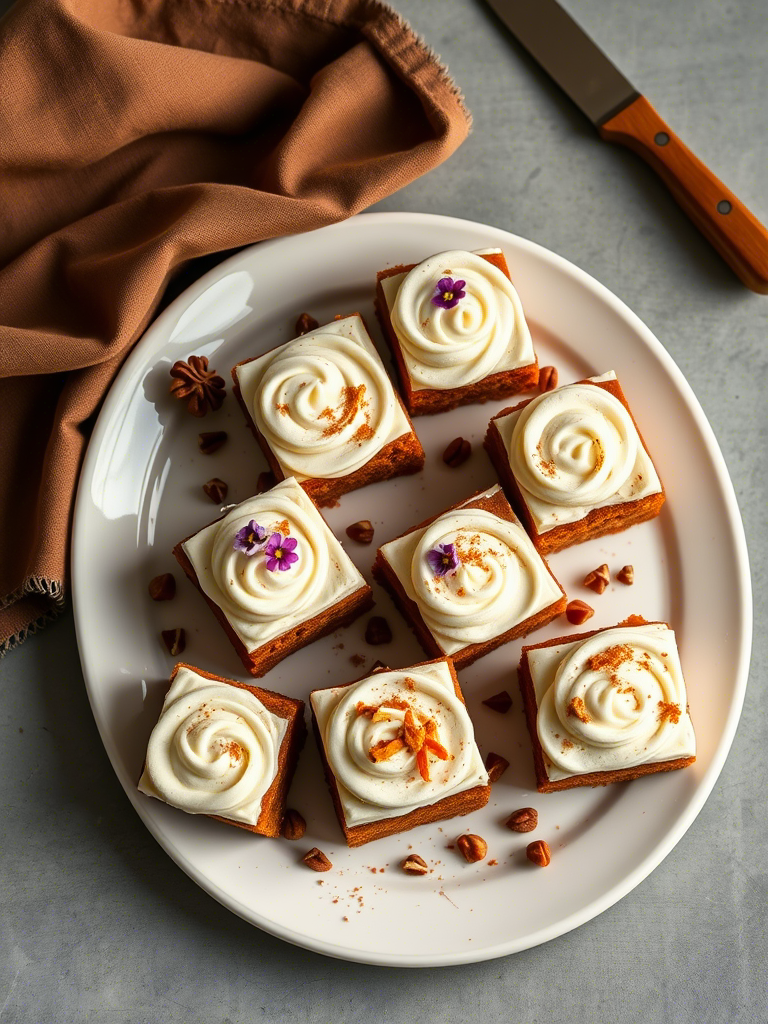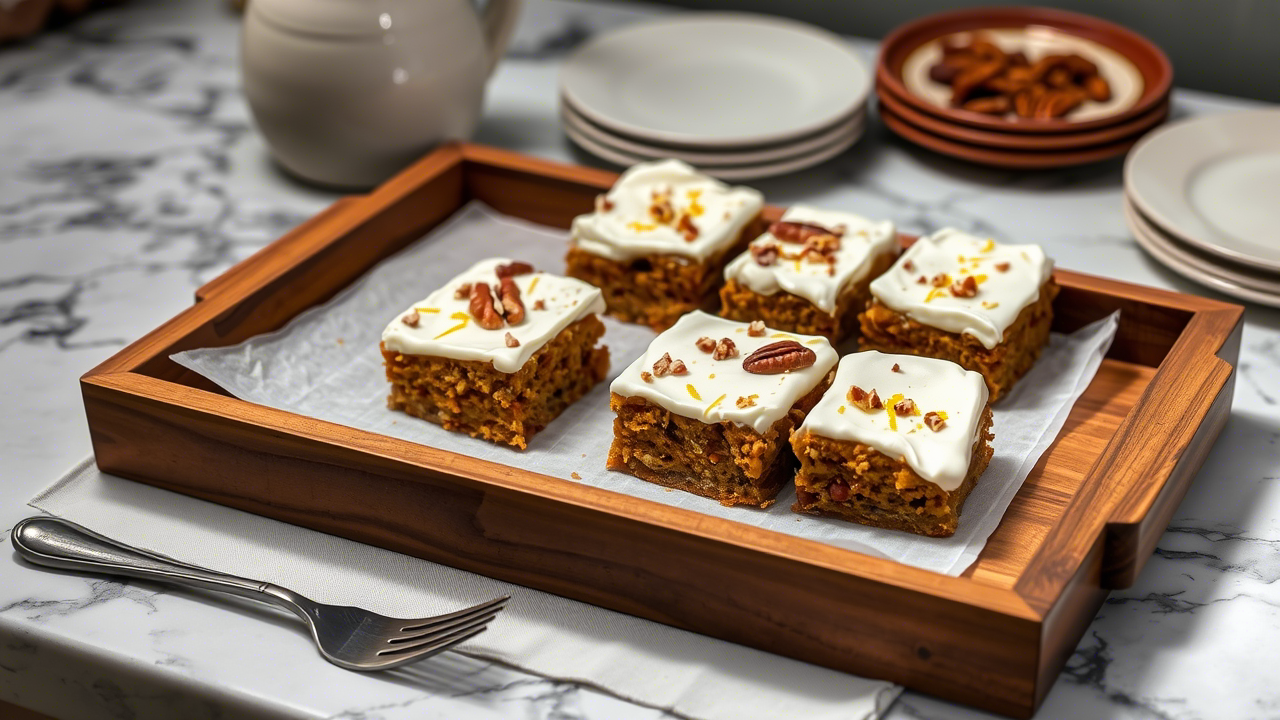If you’ve ever bit into a carrot cake bar and paused, not just because of its moist crumb but because something inside you whispered damn, that’s perfect—you’re in the right place.
These aren’t your nana’s cake bars. This is a chef’s take. Precision meets indulgence. Carrot cake bars with cream cheese frosting may sound simple, but in the hands of a culinary professional, they transform into something deeply nostalgic and impossibly decadent.
We’re talking complex spice profiles, exact baking science, texture that straddles the line between cake and blondie, and a cream cheese frosting so balanced it’ll make pastry chefs weep a little (on the inside). This guide is for chefs, bakers, and those of us who know mise en place isn’t just cute French jargon.
Let’s tear this classic apart. Then rebuild it into something that sings.
What Makes a Great Carrot Cake Bar?
Moisture. Texture. Spice. Structure.
That’s your framework.
Too often, carrot cake bars lean cake-y—fluffy to the point of collapse. Or they go the other direction and become dense, oily bricks that make you question why you even started baking.
Here’s the truth. A perfect carrot cake bar should have:
- A dense-but-tender crumb
- Complex, layered spice
- Consistency across the pan (edges should not be bricks)
- Shredded carrots that melt into the batter, not float like orange string cheese
- And a cream cheese frosting that compliments rather than overwhelms
So, let’s get technical.
The Science of the Crumb
Hydration is everything.
You want your bar to hold moisture without becoming soggy. Carrots, as you know, are 88–90% water. That’s either your best friend or your saboteur. Don’t just dump them in raw and hope for the best. No, no. You’ve gotta wring those suckers out just slightly. Think damp, not dripping.
Try this:
Weigh your shredded carrots. Then place them in a linen towel, press gently—just enough to release about 10–15% of their water. You’re managing water activity here, not creating carrot jerky.
Baker’s tip: Add a touch of Greek yogurt (2–3 tablespoons per batch) to help bind moisture. It acts like a glue stick for tenderness.

The Role of Sugar and Oil
Carrot cake bars need fat. Period.
Butter? Flavorful but rigid. Can cause uneven crumb.
Oil? Moisture queen. But bland.
So why not both?
A 70/30 blend of neutral oil (like grapeseed) to unsalted butter gives you the best of both worlds—fatty moisture with nuanced richness.
On sugar: Brown sugar wins. Specifically, dark brown sugar. The molasses content enhances the warmth of the spice. It’s not just sweet. It’s complex.
Granulated sugar? Use only a touch (¼ cup max in most recipes) to provide structure. Think of it as scaffolding, not the main show.
Spice Strategy: Don’t Be Basic
If you’re still using just cinnamon in your carrot cake, I have a chef’s knife you can borrow—to cut that habit out.
The holy trinity?
- Cinnamon (obviously)
- Ground ginger (for edge)
- Nutmeg (for warmth)
- And… hint of allspice or white pepper if you’re feeling wild
Freshly grated nutmeg? Always. Pre-ground loses its punch faster than your last kitchen intern during brunch rush.
Too much spice, though, and you drown the carrot. Balance is your religion here.
Flour and Structure: Know Your Ratios
Use all-purpose flour. Pastry flour is too weak; bread flour is a cement truck in disguise.
Here’s the rough ratio that works like a charm:
- 1½ cups flour
- 1 tsp baking powder
- ½ tsp baking soda
- ½ tsp kosher salt
Don’t go overboard on leavening agents. Carrot cake bars aren’t soufflés. You want lift, not domes.
Here’s a trick: Sift your dry ingredients twice. It lightens the flour just enough to create an even, tender rise.

Mix-Ins: Less Is Always More (Unless It’s Not)
Nuts? Sure. But chop ‘em fine. Nobody wants to bite into a walnut the size of a golf ball.
Raisins? Divide the room. Soak them in orange juice first if you must.
Crushed pineapple? A touch, not a flood. About ¼ cup drained per batch, max. Otherwise, you risk gummy bars.
Don’t use shredded coconut unless you’re baking for someone who specifically asked. Otherwise it feels like glitter in your food. Unexpected. Stubborn. Texturally confusing.
The Pan, the Bake, the Patience
Use a light-colored 9×13 aluminum pan. Dark pans brown too quickly on the bottom. Glass pans? Inconsistent heat, too finicky.
Grease and line with parchment. Not optional. You want clean edges and zero sticking.
Bake at 325°F (163°C). Yes, lower than most suggest. The bars bake evenly this way. No burnt bottom, no undercooked center.
Bake time? Around 30–35 minutes. Start checking at 28. A toothpick should come out with a few moist crumbs. Not wet. Not dry. Think Goldilocks.
Let it cool. Fully. Don’t you dare frost it warm. Cream cheese melts faster than your patience in a heat wave.
Let’s Talk Frosting: The Power Move
There are two types of cream cheese frostings:
- The kind that holds its shape.
- The kind that drips like butter off toast.
For carrot cake bars, you want #1.
Here’s the formula:
- 8 oz full-fat cream cheese (not whipped, not low-fat, not negotiable)
- ¼ cup unsalted butter, softened
- 1¾ to 2 cups powdered sugar
- ½ tsp vanilla extract
- Pinch of salt
- Optional: zest of ½ lemon for brightness
Beat the butter and cream cheese together first. Like, really beat it—full 3 minutes on medium-high. It needs to be fluffy before the sugar even enters the chat.
Then add sugar gradually. Don’t dump it. You want smoothness, not grit.
Refrigerate it for 10 minutes before spreading. Makes it easier to work with and prevents the “melt and slide” problem.
Expert Moves and Pro Tweaks
- Add a tablespoon of toasted milk powder to the batter. Enhances depth. Think caramel meets cream.
- Fold in ½ tsp orange zest to the frosting. Makes the whole thing pop.
- Want a gourmet twist? Add 1 tsp of bourbon to the frosting. Subtle warmth. Grown-up flavor.
Texture Hack: Add 2 tablespoons of almond flour to your AP flour mix. Slightly nutty, subtly moist, more interesting crumb.
Common Mistakes (And Why You Should Never Make Them Again)
1. Overmixing the batter
Carrot cake is not banana bread. Fold just until combined. No more. No less.
2. Underbaking the center
You can’t fake your way through raw batter. Check multiple spots. Cool the bars in the pan, not on a rack.
3. Using pre-shredded carrots
Don’t do it. Ever. They’re dry. They’re sad. They taste like the inside of a hotel fridge. Shred your own—medium holes, not fine.
4. Oversweetening the frosting
If your frosting tastes like a sugar coma, cut back. Let the tang of the cream cheese do its job.
Emerging Trends in Carrot Cake Bar Evolution
Professional kitchens are turning these humble bars into plated desserts.
We’re seeing:
- Carrot cake bars with brûléed tops (oh yes, a torch gets involved)
- Cream cheese mousse layers instead of traditional frosting
- Add-ins like pistachios or dried mango for a Middle Eastern twist
- Sous-vide carrot purees for consistent texture infusion
And don’t forget the “mini” trend. Tiny, two-bite carrot cake bar squares served with espresso? Perfect for cafés and pop-up menus.
Real-World Example: A Cafe That Did It Right
At Mill & Timber in Portland, Oregon, the head pastry chef swapped brown sugar for maple syrup and folded in roasted carrots instead of raw. The result? A denser, earthier bar with richer flavor.
They sold out daily for 3 months straight.
Moral of the story? Don’t be afraid to tinker—but understand the science before you go rogue.
Final Thoughts: What You Should Really Remember
Carrot cake bars may seem simple. But simplicity is deceptive.
To get them right, you need to balance moisture, fat, spice, and structure like you’re building a miniature culinary cathedral.
Don’t rush. Don’t guess. Taste. Adjust. Respect the process.
Because when done right, these bars aren’t just dessert. They’re the kind of thing that makes people close their eyes and say whoa after the first bite.
And if you’re a professional, that reaction? That’s the gold medal.
So now, go make some bars worth remembering.
Maybe even worth writing about.
FAQs
What makes carrot cake bars different from traditional carrot cake?
They’re denser, slightly chewier, and cut into handheld squares instead of slices.
Can I use pre-shredded carrots for this recipe?
Nope—pre-shredded carrots are too dry and lack flavor; always shred fresh.
Why mix butter and oil instead of using just one?
The combo gives both rich flavor (butter) and moist texture (oil).
What kind of flour works best for carrot cake bars?
All-purpose flour gives the perfect structure—avoid cake or bread flour.
How do I keep the cream cheese frosting from being runny?
Beat butter and cream cheese thoroughly, add sugar slowly, and chill before using.
Can I freeze carrot cake bars with the frosting?
Yes, freeze them in a single layer first, then wrap tightly for best results.
Why lower the oven temp to 325°F instead of 350°F?
Lower temp ensures even baking without burnt edges or gooey centers.
Are there any good substitutions for nuts or raisins?
Chopped dates, dried cranberries, or leave them out—totally optional.
How long do carrot cake bars stay fresh?
They last up to 4–5 days in the fridge, covered airtight.
Can I make these gluten-free?
Yes—swap flour with a 1:1 gluten-free blend and check all mix-ins.

Mariana is a passionate home cook who creates delicious, easy-to-follow recipes for busy people. From energizing breakfasts to satisfying dinners and indulgent desserts, her dishes are designed to fuel both your body and hustle.
When she’s not in the kitchen, she’s exploring new flavors and dreaming up her next recipe to share with the Foodie Hustle community.

